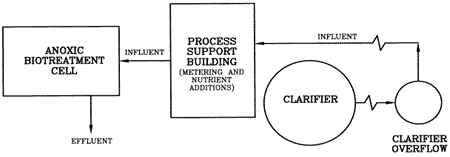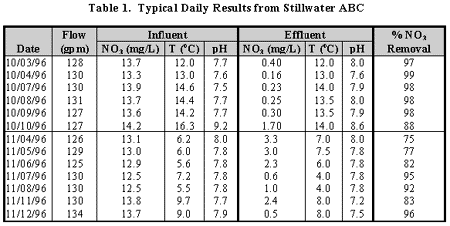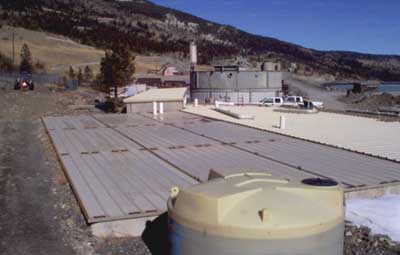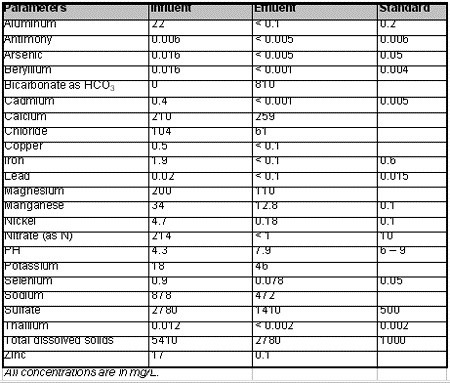Analyzing a new biological treatment process for wastewater
By Mark Reinsel, Ph.D., P.E.
Contents
Nitrate removal
Selenium removal
Perchlorate removal
Sulfate and metals removal
Costs
Removal of nitrate, selenium, perchlorate or other parameters from wastewater to meet discharge limits is often problematic and costly. An effective yet simple process called the Anoxic Biotreatment Cell (ABC) was developed to provide an engineered treatment system, which is more reliable than passive treatment, yet simpler and less expensive than conventional biological or physical/chemical options. Initially developed to help a large mine meet its discharge limit for nitrate, the process has been applied in bench-scale, pilot-scale and production-scale tests for removal of nitrate, selenium, perchlorate, sulfate, metals and acidity. It appears promising for treating a wide range of industrial wastewaters or groundwater.
The ABC is a packed-bed reactor with addition of an external carbon source, usually methanol. The distinguishing features of the ABC are:
- Natural reactor media, which may be available on-site;
- Low-temperature operation (as low as 2°C);
- A simple yet flexible reactor configuration (typically in-ground, upflow, insulated); and
- A low excess phosphate concentration to enhance microbial activity.
Nitrate removal
Nitrate is normally present in mining waters as a result of blasting activities using ammonium nitrate or dynamite. It may also be present in groundwater and surface water in agricultural areas from fertilizer use, or in municipal and industrial waste streams after the aerobic degradation of ammonia. Dissolved nitrate may be removed from water through the action of denitrifying bacteria, which convert nitrate to nitrogen gas. This action, called denitrification, can only occur in environments that are anaerobic (no oxygen) or anoxic (low oxygen concentration).
Traditional approaches to nitrate removal include biological treatment and physical/chemical processes. Wetlands or passive bioreactors are low-cost biological approaches but require a large amount of land and their effectiveness is often short-lived. Conventional bioreactors are fully engineered and effective, but at a high cost. Physical/chemical methods such as reverse osmosis or ion exchange can be quite effective but have high capital and operating costs, and have the additional disadvantage of a waste stream.
As a solution to these problems, a production-scale ABC was designed by Hydrometrics, Inc. (Helena, MT) and the Stillwater Mining Company, and installed at the Stillwater Mine near Nye, Montana. The ABC is a "semi-passive" bioreactor which utilizes pressurized flow and nutrient addition, yet has few moving parts and requires little maintenance. The ABC and its process support building were placed next to an existing clarifier, which removes suspended solids prior to the ABC and the ultimate discharge to existing infiltration ponds (Figure 1). The system began operating in January 1996.
Design objectives of the production-scale ABC were to achieve 50 to 80 percent removal of nitrate at a flow rate of 100 gallons per minute (gpm). The system was sized to provide a hydraulic residence time of two hours (in contrast, wetlands or passive bioreactors are typically designed for a residence time of several days). Typical influent water contained 12 to 20 mg/L of nitrate (as N) at a temperature of approximately 10°C. The reactor was inoculated with bacteria from a municipal denitrification unit. A specialized psychrophilic (low-temperature) bacterial consortium developed naturally in the reactor to effectively remove nitrate at the temperatures observed at the site.

Typical results from two representative periods in October and November 1996, which was shortly after start-up, are shown in Table 1. These time periods were chosen because they occurred: a) after several operational improvements were implemented, and b) while the temperature began to decrease. Similar results have been obtained since this time. Flow rates during these two months averaged approximately 130 gpm and in November 1996, the temperature was significantly below the design temperature of 10°C.

Due to the encouraging results, the ABC treatment system at the Stillwater Mine was subsequently upgraded and expanded several times. The system currently has a treatment capacity of 1100 gpm. The main part of the system is shown in Figure 2. According to Bruce Gilbert, environmental affairs manager for Stillwater Mining, the ABC was implemented to handle the majority of the company's nitrate-removal needs because of these advantages:
- Low capital and operating costs;
- A relatively small footprint;
- Minimal sludge generation; and
- Flexibility in use of either natural or artificial media.

A second Anoxic Biotreatment Cell was designed by Hydrometrics, Inc. and constructed at an operating gold mine in South Dakota in 1997. The objectives at this site were to eliminate: a) the cost of operating an ion exchange plant (approximately $1 million/year), and b) disposal of ion exchange brine, which was both costly and inconvenient. After successful bench-scale testing, the system was designed in early 1997, constructed at the mine during the summer and started up in October. By early December 1997, the system was operating at the design flow rate of 200 gpm with approximately 50 percent nitrate removal; by February 1998, nitrate removal had increased to approximately 80 percent. The water at the gold mine initially contained approximately 110 mg/L of nitrate (as N); this reactor was designed for a six-hour residence time to remove the nitrate required. Both design objectives were met soon after start-up of the ABC. (Return to top)
Selenium removal
Several conventional treatment technologies can be used for selenium removal—reverse osmosis (which produces a concentrated reject stream) and ion exchange (which produces a regeneration brine). A more recent technology for selenium removal is ferrous iron addition, which reduces dissolved selenium to elemental selenium while ferrous iron is oxidized to the ferric form. However, large amounts of iron must be added to remove even trace amounts of selenium, and a light, high-volume sludge is generated.
In the ABC, bacteria reduce dissolved selenium (selenate or selenite) to elemental selenium. The result is a dense, low-volume precipitate which will either remain in the bioreactor or can be removed through filtration. The same bacterial consortium which reduces nitrate also reduces selenium. Nitrate is consumed preferentially; because selenium removal is less efficient, longer hydraulic residence times are generally required for selenium removal compared to nitrate removal.
Groundwater from a large copper mine was treated in an ABC bench test (a continuous-flow column) in 1998. This water had a low nitrate concentration (less than 1.0 mg/L), with an initial selenium concentration of approximately 1.2 mg/L. Nearly all of the selenium was present as selenate (Se6+). Several residence times were evaluated for selenium removal during the experiment. Up to 97 percent of the initial selenium was removed through bacterial reduction and subsequent filtration (Table 2).

(Return to top)
Perchlorate removal
The ABC process was recently evaluated in bench-scale tests for removal of nitrate and perchlorate (ClO4-) from groundwater. This groundwater, located underneath an operating explosives plant, contained approximately 280 mg/L of nitrate (as N) and 40 mg/L of perchlorate. Perchlorate is used as an oxidizer in solid missile and rocket fuel, in automobile air bag inflation systems, and is reported to be present in lawn fertilizers in low concentrations. Perchlorate is used as an electron acceptor by a number of bacterial strains under anoxic conditions, and its removal was anticipated in the ABC along with nitrate.
Biological removal of nitrate and perchlorate was evaluated in two column tests operated in parallel, using acetic acid and molasses as the respective carbon sources. Denitrification was effective in both column tests. Effective perchlorate removal was seen only in the column test using molasses. This effluent water met the perchlorate standard of 0.018 mg/L (Table 3).

(Return to top)
Sulfate and metals removal
Under the proper operating conditions, sulfate-reducing bacteria (SRB) will also thrive in the ABC. SRB produce hydrogen sulfide, which reacts almost immediately with many dissolved metals to produce insoluble metal sulfides. The geochemical reaction of many metals with H2S produces effluent metals concentrations that are typically very low, and are commonly below their respective analytical detection limits using EPA-approved laboratory methods.
Heap leach water from a large gold mine in Nevada was recently treated in column tests using the ABC for removal of parameters which exceeded standards. The standards used were derived from the federal Safe Drinking Water Act and are used by the State of Nevada for protecting waters of the state. In this case, the ultimate objective was to ensure that future discharges from the heap would not negatively affect groundwater, yet avoid more costly conventional treatment options such as lime precipitation.
Without treatment, the heap leach water exceeded standards for sulfate, total dissolved solids, pH, nitrate, aluminum, antimony, arsenic, beryllium, cadmium, iron, lead, manganese, nickel, selenium and thallium. In this column test, heap leach water was treated at a 24-hour residence time.
The standards for pH and nitrate were met after several weeks of column operation. Standards for these parameters, along with selenium, were met directly due to biological activity. Metals standards were met after continued column operation due to a combination of the pH increase (from biological activity) and sulfide precipitation. The concentrations of sulfate, total dissolved solids, nickel and manganese were significantly reduced but drinking water guidelines were not met. Analytical results are shown in Table 4. Bicarbonate was produced through biological activity. (Return to top)
Costs
The ABC has lower capital and operating costs than alternative technologies for nitrate removal, including conventional biotreatment, ion exchange and reverse osmosis. The estimated installed cost for a 100-gpm system is $100,000 to $200,000; this cost will vary depending on the concentration of nitrate or other parameters to be removed. Monthly operating costs (including operator labor, chemical reagents, electricity and maintenance) are typically $0.30 to $0.70 per 1000 gallons. Reagent costs are approximately 20 percent of this total.

Summary
The Anoxic Biotreatment Cell (ABC) is one method that has been successfully used to remove nitrate, selenium and perchlorate from low-temperature waters at several sites. It combines the low cost of passive biological treatment with the consistent, long-term effectiveness of commercial mechanical systems. A full-scale ABC operating at a metal mine in Montana since early 1996 has consistently removed over 90 percent of the incoming nitrate. Nitrate has also been biologically removed in another full-scale ABC, and in numerous pilot-scale and bench-scale evaluations. Selenium, perchlorate, sulfate, metals and acidity have been successfully treated in ABC bench-scale column tests. (Return to top)
References
EPA, 1993. Manual for Nitrogen Control, EPA/625/R-93/010.
Liessens, J., R. Germonpre, S. Beernaert and W. Verstraete, 1993. Removing Nitrate with a Methylotrophic Fluidized Bed: Technology and Operating Performance. Journal AWWA, Research and Technology.
Logan, B.E., 1998. A Review of Chlorate and Perchlorate Respiring Microorganisms. Bioremediation Journal, Vol. 2, pp. 69-79.
Metcalf and Eddy, Inc., 1991. Wastewater Engineering: Treatment, Disposal, and Reuse. 3rd ed., McGraw-Hill, New York.
Randall, C.W., Barnard, J.L., and Stensel, H. David, 1992. Design and Retrofit of Wastewater Treatment Plants for Biological Nutrient Removal. Technomic, Lancaster, Pennsylvania.
About the author: Mark Reinsel, Ph.D., P.E., is with Hydrometrics Inc. (Back)
For more information on this system or application, visit the Hydrometrics, Inc. storefront, or contact the company at 2727 Airport Road; Helena, MT 59601; Phone 406-443-4150.
Source: Hydrometrics Inc.
Subscribe to our free e-mail newsletter.
